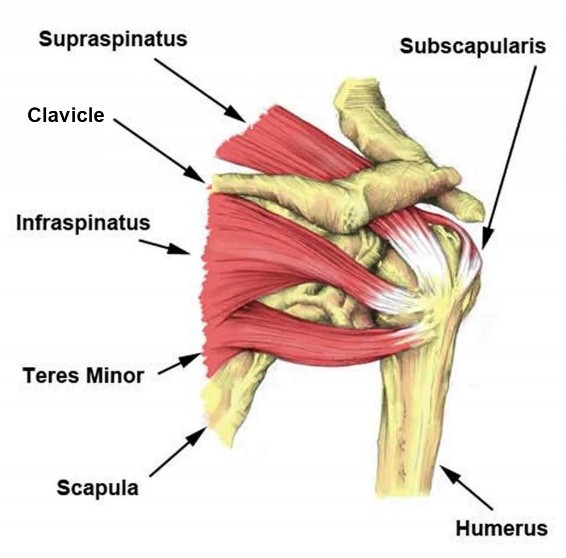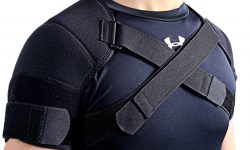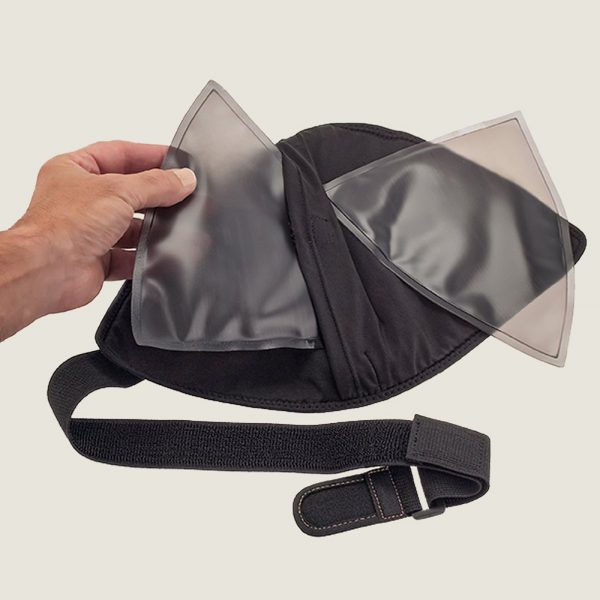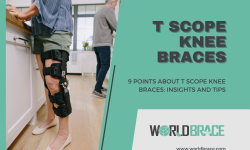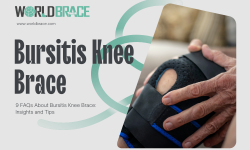BEST shoulder Brace Supplier in China
WorldBrace is the manufacturer of choice for high-quality shoulder braces in China since 2001. We offer a one-stop shoulder brace solution for your business.
Consider purchasing at WorldBrace company. We have a strong R&D team to design, develop, manufacture, and sell the best quality shoulder brace. We have been the trusted Chinese factory of shoulder braces for more than 20 years. WorldBrace has the full shoulder support line including shoulder support brace, cuff brace, shoulder brace, shoulder sleeve, shoulder posture corrector, etc.
If you are looking for shoulder support suppliers and wholesalers? Don’t hesitate to contact us to drive your brand’s growth. Contact us about your custom shoulder support requirements.
Custom shoulder brace Manufacturer
Best Shoulder Supports Wholesaler
- Low MOQ from 1000 PCS with logo
- Products conform to EU and FDA standards
- Pass through Walmart, Target audit
- ISO9001, GMP Certification
- Custom shoulder brace samples in 7 days
- Over 20 years of shoulder support OEM/ODM/OPM experience
The Ultimate Guide For Custom Best Shoulder Brace
What is a shoulder brace?
A shoulder brace is a medical tool that supports the rotator cuff and muscles by sharing the load from the chest area opposite the affected shoulder. This type of brace usually consists of straps and wraps that support the injured shoulder by wrapping the arm and chest area. This utilizes the support of the entire upper body for the affected shoulder. The brace is also a device to prevent future dislocation of the shoulder.
When the shoulder is injured due to impingement or dislocation, the brace can support the socket area, reducing some discomfort by compressing it. It is also a helpful tool when the shoulder area is tense by providing rest and support to have enough time for healing.
The information contained below outlines how to choose the best shoulder brace?
How does the shoulder work?
The shoulder is an incredibly complex collection of bones, muscles, and tendons that work together to allow us to lift, lower, and rotate our arms in their sockets.
It consists of three separate joints that provide the most extensive range of motion of any part of the body. These four joints are the glenohumeral joint, the acromioclavicular (AC) joint, scapulothoracic joints, and the sternoclavicular joint. All four joints move are stabilized through the complex interworkings
Bones: The three main bones of the shoulder are the clavicle (also called the clavicle), the scapula (scapula), and the humerus (the upper arm bone).
Muscles: The muscles of the rotator cuff are the supraspinatus, infraspinatus, teres minor, and subscapularis. These muscles hold the humeral head in the scapula cavity called the glenoid.
In and around the three joints are tendons, ligaments, and cartilage, all designed to stabilize and mobilize the shoulder to perform daily activities large and small. Any damage or inflammation of these structures can cause pain.
Most types of shoulder pain are easily treated with non-invasive options such as shoulder braces for pain, rest, and movement.
When to wear a shoulder brace?
It is often difficult to adequately assess the severity of shoulder injuries and the damaged structures following a sports injury. Therefore, people should always consult a doctor or medical professional before choosing a shoulder brace to determine the exact cause and severity of the injury. Here’s an explanation of some of the most common shoulder injuries people can suffer and how a shoulder brace can help with recovery:
Dislocated Shoulder
Because the shoulder joint is the most mobile joint in the body, it is prone to instability and most prone to dislocation. Shoulder dislocations can occur due to trauma, such as being tackled at a football game or being examined at a hockey game. Shoulder braces can help immobilize injuries as they heal and aid joint recovery after surgery if necessary.
Acromioclavicular Joint (ACJ) Injuries
The small, firm bump you feel at the top of your shoulder is your acromioclavicular joint (ACJ). This joint is very important for overhead and throwing athletes. You can sprain this joint through repeated falls on your shoulder. It can also be dislocated. Shoulder braces help reduce swelling and inflammation of a sprained ACJ, promote recovery, and help stabilize a dislocated ACJ during recovery or after surgery.
Impingement Syndrome
Shoulder impingement syndrome occurs when the arm is repeatedly used for overhead movements and leads to the development of small bone spurs that trap the rotator cuff tendons above the primary shoulder joint. A shoulder brace can help reduce pain and limit movement to heal the area.
Rotator Cuff Tears
The rotator cuff is an essential set of tendons that provide movement and stability to your shoulder. When the rotator cuff is damaged, it can cause pain and weakness. Tears caused by injuries, especially in athletes, benefit from the immobilization and support provided by shoulder braces, as the tear can become larger and more difficult to repair. Shoulder braces also provide a way to strengthen the rotator cuff after it has fully healed, preventing re-injury.
Labral Tears
The labrum is the cushion around the shoulder socket. Labral tears usually occur after a fall or a direct blow to the shoulder but can also occur during a throw or pull. A shoulder brace can provide support and manage blood flow to the area, helping to repair tears and reduce pain.
Shoulder Arthritis
Shoulder arthritis occurs when a joint wears down with age or overuse. Joints lose their original lubrication and become stiff and painful. Keeping your shoulders active and your muscles toned is beneficial. Shoulder braces can help strengthen joints while reducing pain associated with arthritis. Shoulder braces can also help train a joint to maximize its range of motion and reduce the effects of arthritis or help prevent it from occurring.
Are you at risk for shoulder pain?
Due to the location of the injury and the area’s involvement in daily life, it would seem that shoulder pain is inevitable. However, there are a few risk factors that make it more likely. These include:
- Age: Arthritis is often an age-related disease. In addition, rotator cuff injuries are also most common in adults over the age of 40 due to degeneration of tendons, cartilage, and ligaments.
- Activity level: Professional athletes or those who play high-repetition sports (tennis, football, basketball, wrestling, rifle, volleyball) have an increased risk of shoulder injuries.
- Officers: People who sit at a desk all day with their heads outstretched and their neck bent may be at risk for shoulder pain.
- Tradesmen: House painters and carpenters who often work with their arms overhead are more prone to shoulder problems.
How do shoulder braces work?
Many shoulder braces help immobilize the arms and shoulders to support the injured area and minimize movement. This allows the shoulder to heal without undue stress while reducing the risk of re-injury.
Research on how shoulder braces work shows that they can also help improve an athlete’s awareness of arm position, the force exerted by muscles, and coordination with other muscles. This is also called proprioception. Improved proprioception helps stabilize the shoulder, prevent injury and maximize performance.
Some shoulder braces also provide resistance, which helps strengthen the shoulders during training as muscles have to work harder to perform certain activities due to resistance. This can also improve performance, enhance weak structures in the shoulder and arm, and help repair existing damage.
Types of Shoulder Braces and Supports
Shoulder rests are available for your injury type. For example, if you have mild arthritis, you can choose a more flexible brace (shoulder wrap braces). Or, if a more severe injury causes your pain, your doctor may recommend a fixed brace (shoulder sling arm supports).
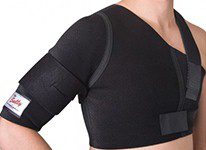
Shoulder wrap braces are designed to conform to the contours of your shoulders, providing light to moderate support and compression while limiting your range of motion. They are fully open to accommodate limited mobility and swelling, and inflammation. Wear them over or under clothing (on either shoulder) and secure with straps around the biceps and chest.
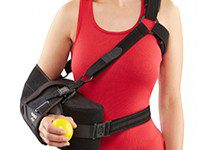
Shoulder sling arm supports are designed to carry arm weight and prevent fatigue during long-term recovery. It includes an arm loop for placing the hand in a neutral position to ensure proper placement.
Things to Consider Before Buying a shoulder brace
1. Material
It is essential to know the exact type of material used for shoulder braces so that you can find the suitable material for your condition.
Neoprene
Neoprene is a lightweight, breathable material that does not restrict movement; most commonly used in knee braces, ankle braces, and ankle braces.
Cotton/Polyester
A heavy, durable material that will rub against the skin if not properly; ideal for everyday shoulder rests for extended wear.
Nylon/Nylon Mesh
Nylon is mainly used in each sling because it does a great job of cradling the arms while minimizing weight and bulk.
Copper shoulder brace
Copper, a soft, malleable metal, has long been known as a folk medicine treatment to relieve pain, heal injuries and Sterilize. If you need a copper shoulder brace, you can find us.
2. Left or right shoulder brace
Before buying a shoulder brace, please confirm it is a left shoulder or right shoulder brace because most shoulder brace is only used in the left shoulder or right shoulder. If you need support on both shoulders, you can choose a double shoulder brace.
3. Level of Support
When choosing a shoulder brace, consider the type of injury the brace will support and the amount of support needed. The level of support of the brace should primarily depend on the daily tasks that need to be performed during the injury and the mobility of the individual.
Lightweight, Flexible Support
Provides freedom of movement while still maintaining a level of support. Basic level support brackets are usually made of elastic fabric and are smaller. These are great to wear while sleeping as they are more comfortable than those designed for extra support or to wear on a regular workday. Some have a strap that goes through the chest to hold the brace in place, and there are made of soft, stretchy neoprene.
Medium Level Of Support
This type of brace works well after the first week of injury because it provides enough support without restricting your range of motion. A medium support brace usually stretches less and covers more of the shoulder. This level of support is usually effective for athletes because it provides more support than the basic support, but it still allows for a lot of movement. Some are designed with built-in heat therapy, or a gel pack can be inserted for cold or heat therapy.
Heavy/Stable Level Of Support
If you are looking for maximum support, this will be the type of brace you need. It secures your shoulder to stretch it gently. A high-support brace should be worn during recovery from surgery or severe injuries where the shoulder must be immobilized. These configurations hold the shoulder in place to correct the injury or prevent further injury. Wearing this type of shoulder should not be used for any activity, including everyday tasks.
4. Hot or cold therapy
After an injury or shoulder pain, heat or cold therapy can be beneficial in reducing pain and inflammation.Cold packs cause blood vessels to constrict, which reduces swelling and bleeding. However, applying heat packs can cause the blood vessels to dilate, making them larger than normal, allowing more blood to flow through them.
Both treatments are helpful for pain relief but are used for different periods so that they won’t affect your injury.
Some braces have pockets that you can put the bag in to provide cold or heat therapy throughout the day. Others offer elastic wraps with Velcro straps that allow you to put the gel pack in.
Microwave the heat pack for 20-30 seconds and insert it into the holder’s pocket to apply heat therapy. For cold therapy, place ice packs in the freezer for at least 45 minutes, then insert them into the holder’s pocket holder.
Note that using ice packs for extended periods is not recommended as they can damage the skin by reducing the skin’s temperature.
5. Size
Shoulder braces are made in many different sizes and should be chosen based on your arm length, wrist circumference, and bust measurements. Alternatively, opt for the adjustable shoulder rest.
6. Price
A simple neoprene should brace readily available for less than $10. If you’re looking for a good quality shoulder support rest at a mid-range price, you’ll get your price back around $40. If you buy directly from the manufacturer, the price only be around 1/4 of the retail price
How to care the shoulder brace?
In general, you should wear a shoulder brace almost all the time. Some are not designed for showering or exercising, so check the instructions to see if this applies to you. It can be washed when not worn.
If your should support doesn’t have any metal parts, you can wash them every few days. Larger metal structural supports should be wiped down with a damp towel at the end of each day.
If you find any parts loose or worn, you should replace those parts. If the entire stand is attached without any removable parts, you may need to buy a new one.
The more you maintain your shoulder straps, the longer it will last.
How to put on a shoulder brace?
To use a shoulder sling arm support, you must first place it on your shoulder. The middle bar should be parallel to the top of the arm and elbow. The straps will wrap around your back, and you’ll secure it with a buckle.
As for a shoulder wrap brace, it will sit under your armpit or the opposite arm for comfort. You may also need to readjust the straps to get the correct fit.
Can you sleep with a shoulder brace on?
Shoulder braces can reduce nighttime pain, but they must be used with care. Follow these tips and remember to consult your doctor if you have any questions.
- Wear the stand over clothing to avoid skin irritation
- Sleep on your back to avoid excessive stress on your joints
- Keep the area dry and clean
- Do not wear a shoulder brace if it causes pain or discomfort
How long to wear a shoulder brace?
During the healing process, the shoulder supports the arm to reduce the weight of the joint. They also help prevent fatigue and limit range of motion. Remember that the sling should not be worn for too long or the joints will become stiff. Fractures usually take 2 to 4 weeks, but this time can vary depending on the severity of the injury.
How to make a shoulder brace?
The major manufacturing production processes of shoulder brace include:
1. Sourcing Raw Material → 2. Neoprene Slicing → 3. Composite & Lamination → 4. Embossed & Perforated (optional) → 5. Pattern Making → 6. Tailoring & Cutting → 7. Printing → 8. Sewing → 9. Finishing Quality Control → 10. Packing And Dispatch
It usually takes 30 days more production lead time to order from raw material to final shipment ready. For more details you want to know, you can contact WorldBrace Team for technique support.
Where to buy a shoulder brace?
There are many ways to get a shoulder brace. Many pharmacies or medical supply stores often carry simple shoulder supports. It is also possible to order shoulder braces directly from the manufacturers or through Walmart, Amazon, and Target
But if you want to buy custom shoulder braces in bulk, you should find a shoulder support manufacturer like WorldBrace. We’ll ensure you get the right shoulder brace for your unique requirements.
The best shoulder brace manufacturer in China
If you are looking for a custom shoulder brace or have any queries about custom shoulder support, please feel free to contact us through email. We have experts that are always ready to assist you and will contact you back within 24 hours to tell you about the possibility of customizing your shoulder brace.
WorldBrace is the best shoulder brace manufacturer in china. Contact us today and find out how, together, we can create a unique shoulder brace that is guaranteed to impress.

